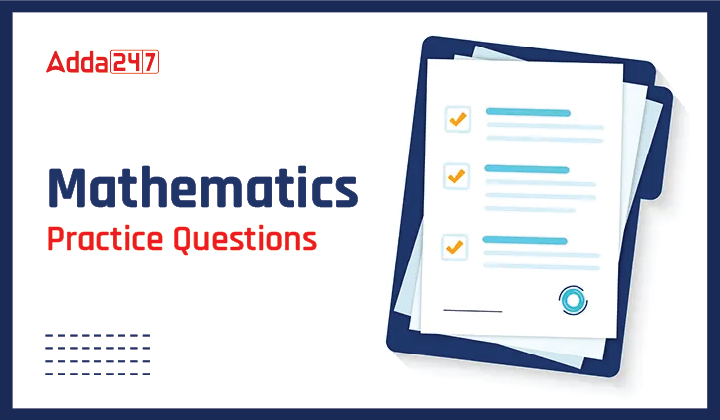
Math practice questions are an excellent way to prepare for any math exam. These questions allow you to practice your problem-solving skills and build your confidence in the subject. Math practice questions can cover a wide range of topics, including algebra, geometry, calculus, and statistics. They can also vary in difficulty, from basic to advanced levels. Its will help for better preparation in upcoming govt. exam
Q1. The divisor is 321, the quotient 11 and the remainder 260. Find the dividend.
(a) 3719
(b) 3971
(c) 3791
(d) 3179
Sol.
Dividend = Divisor × Quotient + Remainder
= 321 × 11 + 260
= 3531 + 260 = 3791
Q2. If two numbers are each divided by the same divisor, the remainders are respectively 3 and 4. If the sum of the two numbers be divided by the same divisor, the remainder is 2. The divisor is:
(a) 9
(b) 7
(c) 5
(d) 3
Sol.
Total remainder = 3 + 4 =2
Now, 7 = 2 + divisor
Divisor = 5
Q3.Find the greatest number which divides the numbers 1461, 4185 and 4227 leaving remainder 2, 3 and 4, respectively.
(a) 43
(b) 41
(c) 48
(d) None of these
Sol.
Greatest number which divides the numbers 4061, 4185 and 4227 leaving remainders 2, 3 and 4 will be equal to HCF of (4061 – 2), (4185 – 3), (4227 – 4)
i.e. HCF of 4059, 4182 and 4223.
Since, HCF and 4059, 4182 and 4223 is 41. So, the required number is 41.
Q4. Four metal rods of lengths 78 cm, 104 cm, 117 cm and 169 cm are to be cut into parts of equal length. Each part must be as long as possible. What is the maximum number of pieces that can be cut?
(a) 27
(b) 36
(c) 43
(d) 480
Sol.
Given, lengths of four metal rods are 78, 104, 117 and 169 cm.
Now, 78 = 13 × 2 × 3
104 = 13 × 2 × 2 × 2
117 = 13 × 3 × 3
169 = 13 × 13
Length of each piece of rod as possible.
HCF = 13 cm
∴ Number of pieces = 6 + 8 + 9 + 13 = 36
Q5. The product of two relatively prime numbers is 143. Find their HCF.
(a) 3
(b) 9
(c) 13
(d) 1
Sol.
Two divisible prime numbers are exactly divisible by 1 only.
∴ Required HCF = 1
Q6.Of the three numbers, the first is twice the second and is one fourth of the third. If the average of these numbers is 55, the numbers in order are.
(a) 30, 15, 120
(b) 90, 45, 30
(c) 48, 96, 24
(d) 48, 24, 96
Sol.
Second number = x (let)
First number = 2x
Third number = 8x
so x + 2x + 8x = 55 * 3
=>11x = 55 * 3
x = 5 * 3 = 15
Other numbers are : 30 and 120
Q7.The least number which when divided by 4, 6, 8, 12 and 15 leaves a remainder of 2 in each case is:
(a)146
(b)122
(c)120
(d)118
Sol.
L.C.M. of 4, 6, 8, 12, and 15 = 120
So Required number = 120+2 = 122
Q8. What should be the maximum value of Q in the following equation?
59P – 7Q2 + 9 R6 = 823
(a) 7
(b) 5
(c) 9
(d) 6
Sol.
For Q to be maximum P and R will also is maximum,
i.e. P = R = 9
so, by putting the value of P and R in
5P9 – 7Q2 + 9R6 = 823
We get Q = 7
Q9. 5 men or 9 women can do a piece of work in 19 days. In how many days will 3 men and 6 women do it?
(a) 10 days
(b) 12 days
(c) 14 days
(d) 15 days
Sol.
9 women = 5 men ⇒ 1 woman = 5/9 men
⇒ 6 women =(5/9×6)men = 10/3 men
3 men + 6 women =(3+10/3)men =19/3 men
Let the required number of days be x
More men, less days
19/3:5∷19:x ⇒ 19/3×x=(5×19)
⇒ x=(5×19×3/19)=15 days
∴ Required number of days = 15
Q10. Out of three numbers, the first is twice the second and half of the third. If the average of three numbers is 56, the difference of first and third number is:
(a) 12
(b) 20
(c) 24
(d) 48
Sol.
Let the first number be x.
Then, second number =x/2 and third number = 2x
⇒ 1/3 (x+x/2+2x)=56
⇒ 1/3 (3x+x/2)=56
⇒ 7x/6=56
⇒ x=(56×6/7)=48
∴ Required difference = (2x – x) = x = 48









